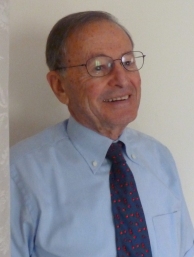
Sergio Pizzini is a former full professor in Physical Chemistry at the University of Milano-Bicocca. He holds a Doctor Degree in Chemistry and a PhD in Electrochemistry.
Professional Carrier
His professional carrier started at the Joint Research Centre of the European Commission in Ispra (Italy) and later in Petten (Nederland), committed to studies of a fuel for a molten salt reactor, within a Joint Program with the Oak Ridge Centre in USA. In this frame he carried out innovative studies dealing with the electrochemistry of molten fluorides, including the development of a standard hydrogen electrode in molten KHF2. After leaving the Commission at the beginning of 1970 he joined the University of Milano as Associated Professor, where he started a systematic investigation on solid electrolytes. In this context he developed fundamental and applied studies, which succeded also in the realization of a prototype of a solid electrolyte gas sensor and of a solid state sensor for the determination of the stoichiometry of nuclear oxide fuels (Patent).
Still maintaining his position at the University, in the year 1975 he was nominated Director of the Materials Department at the Corporate Research Centre of Montedison in Novara, to start an activity on advanced materials for electronics. In less than five years of activity he succeded in launching several studies on compound semiconductors (InP), on magnetic oxides iron and chromium based and in initiating a support R&D activity for the brand new Montedison initiative in EG silicon production and silicon crystal growth.
Montedison and founded the Heliosil Company in 1979, where as its CEO he studied a process for the production of solar grade silicon (patent) and patented as well a furnace and a process for the directional solidification of silicon in multicrystalline ingots. Inthe
frame of this activity he was the first in proposing and patenting the use of quartz crucibles coated with silicon nitride for silicon ingot casting . In the year 1982 he left any outside duty for serving the University of Milano, and later, the University of Milano-Bicocca, as full Professor of Physical Chemistry.
In this last period of activity, in addition to his teaching and management duties, he carried out systematic studies on semiconductor silicon, mostly addressed at the understanding of electronic and optical properties of point and extended defects of Czochralski, multicrystalline and nanocrystalline silicon in the frame of national and European Projects, using EBIC, LBIC, Photoluminescence, EXAFS and Raman spectroscopies.
He also served the University as founder and Director of the Doctorate School on Nanotechnology Science, as founder and first Director of the Doctorate School of the Faculty of Sciences and as the Rector’s Delegate for the international Relations of the University of Milano-Bicocca until the end of 2005. From November 2005 and until October 2008, after his formal retirement, holded a position of part time professor, teaching Physical Chemistry for the Course of Material Science. His cooperation with the University continues today on voluntary basis.
He was Chairman or Co-Chairman of a number of International Symposia in the Materials Science field in Europe and abroad. In the last years, after retirement, he Co-chaired the EMRS 2008, 2010, 2012 and 2014 Symposia on Group IV semiconductor materials.
He chaired the Session devoted to Crystalline silicon at the LCES 2011 Conference, Dalian (China) October
22-26, 2011.
His scientific expertise spans from solid state electrochemistry and materials science to the physics and physical chemistry of semiconductor materials and to the most advanced processes addressed at the production and refining of silicon for photovoltaic uses.
Sergio Pizzini is author of more than 250 technical papers published in international Journals with peer review. He authored or co-authored four books, entitled “Advanced silicon materials for photovoltaic applications” (2012)
Wiley & Sons Ldt; “Physical Chemistry of semiconductor materials and Processes”
(2015) Wiley & Sons; “Silicon, Germanium, and Their Alloys: Growth, Defects, Impurities, and Nanocrystals”,
(2015) CRC Press and “Solar Silicon Processes, Technologies,
Challenges and Opportunities”, (2016) CRC Press.
Curriculum Vitae
CREDITS:
Martina Zanarini - Softec
Prof. Sergio Pizzini - University of Milano Bicocca
mobile 0039 3316685224 -
sergiopizzini2011@gmail.com